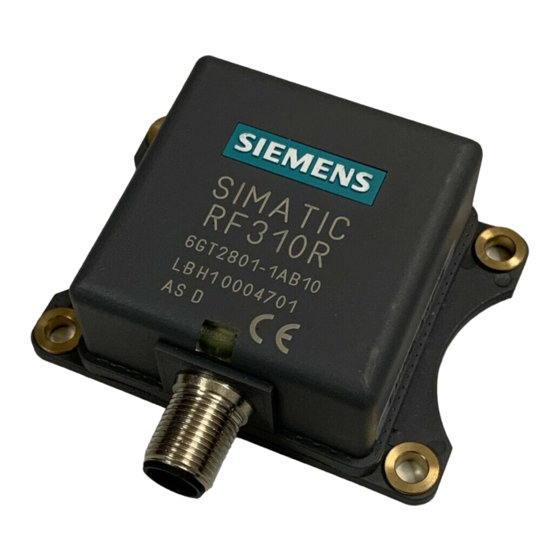
Summarization of Contents
Introduction to SIMATIC RF300 Manual
Navigating the System Manual
Explains how to navigate the document structure and chapter purposes.
Document Purpose and History
Details the manual's purpose, scope, and edition history.
Safety Information
Safety Levels and Personnel
Defines safety alert levels (Danger, Warning, Caution, Notice) and qualified personnel.
Usage, Repairs, and Expansion
Covers prescribed usage, repair policies, and system expansion guidelines.
System Overview
RFID Systems Overview
Introduces Siemens RFID systems and their role in material flow.
SIMATIC RF300 System Overview
Describes the RF300 system, its applications, and components.
RF300 Application Areas
Details main applications and customer benefits of SIMATIC RF300 in industrial environments.
RF300 System Components
Explains the function of communication modules, readers, and transponders.
RF300 Technical Data
Lists key technical specifications for the RF300 system.
RF300 System Planning
Application Planning Criteria
Outlines criteria for selecting RF300 components based on application needs.
Transmission Window and Distance
Explains the inductive field, transmission window, and read/write distance.
Width of Transmission Window
Provides a formula to determine the width of the transmission window.
Transponder Motion and Operation Modes
Covers transponder movement directions and static/dynamic operation.
Transponder Dwell Time Calculation
Defines dwell time and provides formulas for calculation in static and dynamic modes.
Communication (IQ-Sense Interface)
Details communication cycles, data transfer, and time constants for IQ-Sense.
Calculation Example (IQ-Sense)
Provides a step-by-step calculation for user data based on speed and components.
Communication (RS 422 Interface)
Explains asynchronous communication via RS 422, including data transfer rates.
Calculation Example (RS 422)
Demonstrates calculating maximum user data for RS 422 interface based on speed.
Field Data for Components
Presents technical data for transponders, readers, and antennas.
Performance Curves: Speed vs. Data Volume
Shows how transponder speed affects data volume for RF310R (IQ-Sense).
Performance Curves: RF310R (RS 422)
Illustrates data volume vs. speed for RF310R (RS 422) with various transponders.
Performance Curves: RF340R
Displays data volume vs. speed curves for RF340R reader with various transponders.
Performance Curves: RF350R
Shows data volume vs. speed curves for RF350R reader with ANT1 and RF320T.
Installation Guidelines Overview
Provides key points for installing RFID components, considering metal interference.
Flush-Mounting Considerations
Discusses flush-mounting challenges and remedies to counteract reduced transmission window.
Mounting Multiple Readers on Racks
Offers remedies for interference when mounting multiple readers on metal racks.
Metal Effects on Components
Refers to specific sections for conditions when mounting transponders/readers on metal.
Impact of Metal on Transmission Window
Details how metal affects field data (Sg, Sa, L, B) and lists reduction percentages.
Chemical Resistance of Transponders
Lists chemical resistance data for RF320T and RF360T transponders against various substances.
EMC Directives Overview
Addresses the necessity of EMC guidelines and questions related to interference.
Understanding Electromagnetic Compatibility (EMC)
Explains EMC and its three key areas: immunity and emission.
Basic EMC Rules for Installation
Provides elementary rules for shielding, grounding, and cable installation for EMC.
Propagation of Electromagnetic Interference
Explains the three components required for interference: source, coupling path, and sink.
Coupling Paths and Causes
Details the four ways interference can be coupled and common causes.
Cabinet Configuration for EMC
Discusses cabinet configuration, cable installation, grounding, and shielding for EMC.













Need help?
Do you have a question about the RF340R and is the answer not in the manual?
Questions and answers